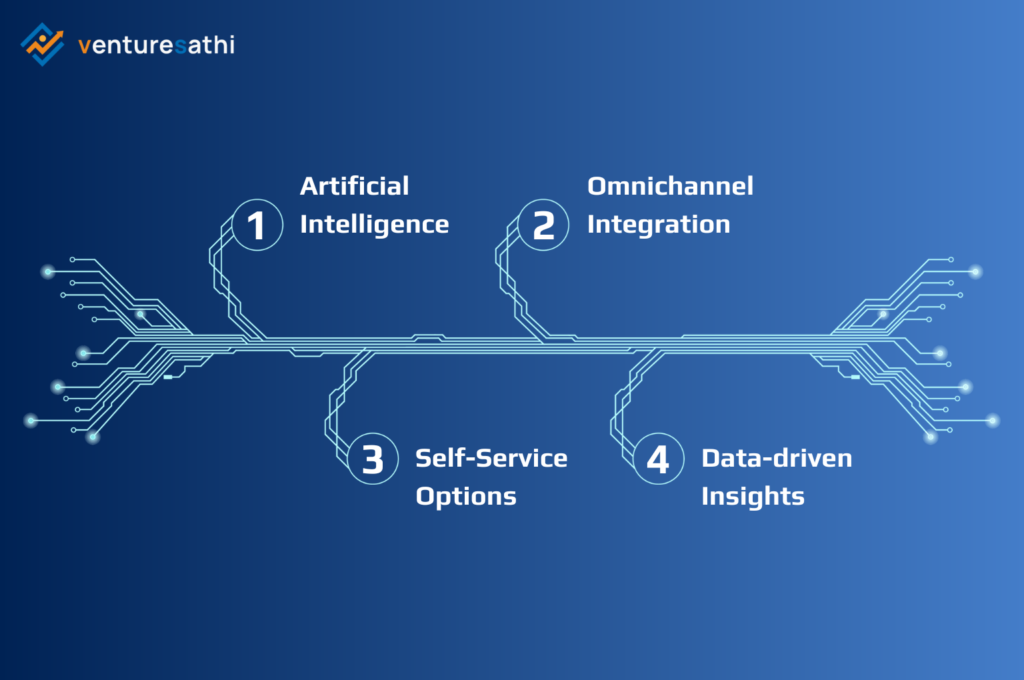Why Companies Outsource Their
Contact Center in 2025
Author

Rohit Gupta
Chief Operating Officer

Contact Center image for Why Companies outsource their contact center in 2025
Contact centers are where customers go when they need help. Think of them as upgraded call centers that handle more than just phone calls. Today’s contact centers manage emails, live chat, social media messages, and phone calls all in one place. Agents use contact center software to quickly pull up your information and solve problems faster.
Here’s what makes them work: When you contact a company through any channel, their system routes your request to the right agent. That agent can see your purchase history, previous conversations, and other details that help them help you. It’s like having a conversation with someone who already knows your story.
The numbers back this up. Research shows that 94% of customers are more likely to buy again after a great service experience. In other words, good contact centers help businesses keep customers, while bad ones send them to competitors.
Here’s what makes them work: When you contact a company through any channel, their system routes your request to the right agent. That agent can see your purchase history, previous conversations, and other details that help them help you. It’s like having a conversation with someone who already knows your story.
The numbers back this up. Research shows that 94% of customers are more likely to buy again after a great service experience. In other words, good contact centers help businesses keep customers, while bad ones send them to competitors.

Image for Why Companies outsource their contact center in 2025
Why Companies Choose to Outsource Contact Center
Running your own contact center is expensive and complicated. Many companies hire outside providers to handle customer service instead. The main reasons include cutting costs by 40-60%, accessing advanced AI technology, getting 24/7 multilingual support, and scaling up or down instantly during busy periods. Here’s why this makes sense in 2025:
Save Money Where Needed
Outsourcing typically costs much less than building your own center. Industry research found that about 70% of companies outsource specifically to cut costs.
Instead of paying for office space, computers, software licenses, and full-time salaries, you pay a predictable monthly fee. The outsourcing partner already has everything set up. For example, customer support agents in the India cost around $8-$14 per hour, compared to $24-$28 in the US or Europe. Those savings add up quickly when you’re handling thousands of customer contacts. In India, Odisha is one of the rising cities to outsource from and why you should start outsourcing today.
You’re basically converting huge fixed expenses into manageable variable costs. No more worrying about rent, utilities, or whether you have enough desk space.
Instead of paying for office space, computers, software licenses, and full-time salaries, you pay a predictable monthly fee. The outsourcing partner already has everything set up. For example, customer support agents in the India cost around $8-$14 per hour, compared to $24-$28 in the US or Europe. Those savings add up quickly when you’re handling thousands of customer contacts. In India, Odisha is one of the rising cities to outsource from and why you should start outsourcing today.
You’re basically converting huge fixed expenses into manageable variable costs. No more worrying about rent, utilities, or whether you have enough desk space.
Focus on What You Do Best
When someone else handles your customer calls and emails, your team can focus on your core business activities. Every hour your managers spend recruiting and training support agents is an hour they’re not spending on product development, marketing, or strategy.
Research shows that businesses outsourcing non-essential tasks can invest more in research and development. If you’re trying to launch a new product while also managing customer support hiring, something’s going to suffer. Outsourcing lets you put your energy where it matters most.
Research shows that businesses outsourcing non-essential tasks can invest more in research and development. If you’re trying to launch a new product while also managing customer support hiring, something’s going to suffer. Outsourcing lets you put your energy where it matters most.
Get Better Technology and Expertise
Top contact center providers specialize in customer service. They employ experienced agents, supervisors, and quality analysts who know how to keep customers happy. More importantly, they invest in technology you might not be able to afford on your own.
We’re talking about cloud-based Contact Center as a Service (CCaaS) platforms, advanced CRM systems, AI tools, and analytics dashboards. These providers often have intelligent chatbots, real-time reporting, and even AI assistants that help agents give better answers. Small and medium businesses especially benefit from this instant tech upgrade.
We’re talking about cloud-based Contact Center as a Service (CCaaS) platforms, advanced CRM systems, AI tools, and analytics dashboards. These providers often have intelligent chatbots, real-time reporting, and even AI assistants that help agents give better answers. Small and medium businesses especially benefit from this instant tech upgrade.
Scale Up or Down as Needed
Business has busy seasons and slow periods. During sales events or holidays, customer inquiries can triple overnight. Other times, they drop to almost nothing.
Adjusting an in-house team quickly is nearly impossible. Outsourcing providers excel at flexibility. They can add more agents during busy periods and scale back when things calm down. You get the right number of people helping customers without paying for idle staff or making customers wait in long queues.
Adjusting an in-house team quickly is nearly impossible. Outsourcing providers excel at flexibility. They can add more agents during busy periods and scale back when things calm down. You get the right number of people helping customers without paying for idle staff or making customers wait in long queues.
Offer 24/7 and Multilingual Support
Many outsourcing providers operate around the clock in multiple languages. Need weekend support? They’ve got teams in different time zones. Do your customers speak Spanish, French, or Mandarin? Many contact center locations provide multilingual agents.
Setting this up in-house would mean hiring staff in multiple regions and managing complex schedules. Outsourcing makes it simple. Even small companies can offer “always-on” global support without the overhead.
Setting this up in-house would mean hiring staff in multiple regions and managing complex schedules. Outsourcing makes it simple. Even small companies can offer “always-on” global support without the overhead.
Better Security and Compliance
Established providers invest heavily in security measures and compliance certifications. Modern outsourcing firms focus more on cybersecurity than ever before, giving you access to advanced data protection and industry compliance (like PCI/DSS for financial services) that would be expensive to build internally.
When customer data is handled safely, it builds trust with your clients.
When customer data is handled safely, it builds trust with your clients.
How Contact Centers Actually Work
Understanding the basics helps you make better outsourcing decisions. Modern contact centers use intelligent routing systems to match customers with the right agents, unified dashboards that show complete customer history, and real-time analytics to track performance and improve service quality. Here’s how these systems operate:
Smart Routing Gets Customers to the Right Agent
When a customer contacts you (phone, chat, social media, email), the system first identifies the communication channel and the type of question. An Automatic Call Distributor (ACD) handles phone calls, while chat platforms manage live messages.
The system then matches the customer with an available agent based on skills, language, or expertise. Good software can even decide whether someone should talk to a human agent or try a chatbot first.
The system then matches the customer with an available agent based on skills, language, or expertise. Good software can even decide whether someone should talk to a human agent or try a chatbot first.
Agents Work from Unified Dashboards
Agents use a single screen that shows everything they need. When a contact comes in, they can see the customer’s information from the CRM system, past interactions, and suggested responses. If someone calls about billing, the agent’s screen automatically shows billing data and common solutions.
This data helps improve service on the spot. If customers are abandoning calls, managers know to add more staff or update the phone menu.
This data helps improve service on the spot. If customers are abandoning calls, managers know to add more staff or update the phone menu.
Shared Knowledge Makes Everyone Smarter
Agents have access to FAQs, product databases, and troubleshooting guides. When one agent transfers an issue to another, the second agent already knows the background. Customers don’t have to repeat their story.
The goal is simple: resolve issues efficiently no matter which channel the customer chose. By connecting communication tools, smart routing, knowledge bases, and analytics, contact centers deliver fast, helpful support.
The goal is simple: resolve issues efficiently no matter which channel the customer chose. By connecting communication tools, smart routing, knowledge bases, and analytics, contact centers deliver fast, helpful support.

Image for when you should consider outsourcing 2025
When Should You Consider Outsourcing?
Outsourcing isn’t always necessary, but it becomes essential when you’re experiencing rapid growth, need 24/7 or multilingual support, have budget constraints, lack in-house expertise, or want your team to focus on core business activities instead of managing customer service operations. Here are the specific situations:
Your Support Requests Are Growing Fast
Maybe a successful marketing campaign or product launch just brought in lots of new customers. If you’re struggling to hire and train enough agents quickly, outsourcing can instantly add capacity. You can ramp up for busy seasons and scale down during slow periods without the hiring headaches.
Your Budget Is Tight
Small and medium companies often find the upfront investment for an in-house center too expensive. You need office space, hardware, software licenses, plus ongoing costs like salaries, benefits, utilities, and internet. Outsourcing converts these fixed costs into operating expenses, often saving significant money.
You Need Round-the-Clock or Multilingual Support
If your business serves international customers or operates across time zones, outsourcing provides a fast solution. Instead of opening a second office or hiring night-shift agents, you can partner with a provider that already offers 24/7 coverage and multiple languages.
Customer Service Isn’t Your Expertise
Maybe you’ve tried handling support internally, but customer satisfaction is suffering or it’s taking too much time away from your main business. Outsourcing gives you instant access to experienced professionals with proven processes.
You Want to Focus on Core Business Functions
Ask yourself: Is running a contact center essential to your core business, or is it a supporting function? If your team spends more time worrying about hiring support agents than developing products or serving customers, it’s time to outsource.
Every hour spent managing customer service operations is an hour not spent on innovation, marketing, or strategy.
Every hour spent managing customer service operations is an hour not spent on innovation, marketing, or strategy.
Where to Outsource from?
Once you decide to outsource, you need to pick a location. The Philippines remains the top choice for English-language support with excellent cultural fit, while India excels in technical support at low costs. Latin American countries like Colombia and Mexico offer nearshore advantages for US companies, and Eastern European locations like Poland provide multilingual European support. Some countries have become global hubs for contact center services due to talent, language skills, and cost advantages.
Philippines: The Global Leader
The Philippines remains the top destination for contact center outsourcing. Filipino agents are known for excellent English communication, Western cultural understanding, and friendly service. They provide neutral accents and can cover 24/7 operations globally.
A 2025 industry ranking calls the Philippines “the undisputed leader among the top 10 call center countries,” noting its combination of service excellence and strong government support for the outsourcing industry.
A 2025 industry ranking calls the Philippines “the undisputed leader among the top 10 call center countries,” noting its combination of service excellence and strong government support for the outsourcing industry.
India: Technical Expertise at Low Cost
India stays in second place, especially for technical and non-voice support. The country has a huge, tech-savvy workforce and very competitive labor costs. Indian contact centers handle everything from basic customer service to complex IT support and back-office functions.
India’s strengths include cost-effective services, high-level technical expertise, and extensive infrastructure.
India’s strengths include cost-effective services, high-level technical expertise, and extensive infrastructure.
Latin America: Nearshore Convenience
Colombia and Mexico have become popular for US companies needing Spanish and English support. They offer nearshore advantages like similar time zones and business hours, plus bilingual agents.
Customer Service Isn’t Your Expertise
Maybe you’ve tried handling support internally, but customer satisfaction is suffering or it’s taking too much time away from your main business. Outsourcing gives you instant access to experienced professionals with proven processes.
Other Growing Destinations
Many countries are expanding their outsourcing capabilities:
- Poland and Malaysia: Known for multilingual support (English, German, Mandarin) and strong telecom infrastructure
- South Africa: English-speaking workforce with cultural alignment to US and UK markets
- Egypt: Emerging hub for Arabic and European language services
- Vietnam and Jamaica: Low costs with increasing English proficiency
- India: Emerging Tier-2 cities with leading infrastructures and skill
Companies choose locations based on language needs, time zones, and cost. The Philippines and India handle most English-language needs at low cost, so they remain the top two destinations globally. For Spanish-speaking customers or US time zone coverage, Mexico and Colombia work well. For European support, Poland or South Africa might be ideal.

Image for What’s new in contact center 2025
What’s New in 2025: AI Automation, CCaaS, and more
The contact center world isn’t just about locations and people anymore. Artificial intelligence now handles routine inquiries and assists agents with real-time suggestions, cloud-based CCaaS platforms enable instant scaling without hardware investments, and hybrid remote work models provide 24/7 coverage with distributed teams. Two major trends are reshaping the industry: artificial intelligence and cloud-based platforms.
AI Makes Everything Faster and Smarter
Companies are using AI to improve both speed and service quality. Generative AI – the same technology behind advanced chatbots – is transforming contact centers.
AI can auto-summarize call transcripts, suggest real-time responses to agents, and power smarter chatbots that handle customer questions. NICE, a major contact center technology provider, explains that AI is “a powerful lever for enhancing service quality, boosting agent productivity, and transforming customer service operations.”
In practice, this means AI tools help agents by highlighting the best answers and learning each customer’s needs. AI also handles simple questions through virtual assistants, freeing human agents for complex issues.
Early AI users report shorter call times, higher first-contact resolution rates, and happier customers. Adding AI chatbots and workflow automation often reduces costs while increasing customer satisfaction.
AI can auto-summarize call transcripts, suggest real-time responses to agents, and power smarter chatbots that handle customer questions. NICE, a major contact center technology provider, explains that AI is “a powerful lever for enhancing service quality, boosting agent productivity, and transforming customer service operations.”
In practice, this means AI tools help agents by highlighting the best answers and learning each customer’s needs. AI also handles simple questions through virtual assistants, freeing human agents for complex issues.
Early AI users report shorter call times, higher first-contact resolution rates, and happier customers. Adding AI chatbots and workflow automation often reduces costs while increasing customer satisfaction.
Cloud Platforms Offer Instant Scaling
Traditional contact centers used bulky on-site phone systems. Now most new centers use CCaaS (Contact Center as a Service) solutions – cloud software for all contact center needs.
This shift brings major advantages. CCaaS lets companies launch and scale contact centers quickly without buying and maintaining hardware. Updates happen automatically, so you always have the latest features.
Many CCaaS platforms include built-in analytics, omnichannel support (customers can switch from chat to phone seamlessly), and AI chatbots as part of the package. Because it’s software-based, centers can add new channels like WhatsApp or video chat almost instantly.
This shift brings major advantages. CCaaS lets companies launch and scale contact centers quickly without buying and maintaining hardware. Updates happen automatically, so you always have the latest features.
Many CCaaS platforms include built-in analytics, omnichannel support (customers can switch from chat to phone seamlessly), and AI chatbots as part of the package. Because it’s software-based, centers can add new channels like WhatsApp or video chat almost instantly.
Hyper-Personalization to deliver personalised CX
Imagine walking into your favorite coffee shop. The barista greets you by name, remembers your usual order, and even suggests a new drink based on what you’ve tried before.
Now, imagine that same level of personalization happening online, across every touchpoint with a brand—your shopping app, streaming service, or bank. This is the power of AI-driven hyper-personalization in customer experience (CX).
Now, imagine that same level of personalization happening online, across every touchpoint with a brand—your shopping app, streaming service, or bank. This is the power of AI-driven hyper-personalization in customer experience (CX).
Self-Service and Omnichannel Integration
Customers increasingly start with self-service options like FAQ pages, chatbots, or automated phone menus before talking to an agent. Smart contact centers expand these options so routine questions get answered automatically.
This “digital-first” approach reduces wait times and improves the customer experience. A website chatbot might solve someone’s issue instantly or route them to the best help channel.
Companies using automation and AI as permanent parts of their operations see costs decrease while contact resolution, employee productivity, and customer satisfaction increase.
This “digital-first” approach reduces wait times and improves the customer experience. A website chatbot might solve someone’s issue instantly or route them to the best help channel.
Companies using automation and AI as permanent parts of their operations see costs decrease while contact resolution, employee productivity, and customer satisfaction increase.

Image for Market leaders in Contact Center 2025
Industry Leaders and Market Size
The contact center outsourcing market is massive and growing fast. Recent analysis puts the global outsourced customer service market at $79.4 billion in 2023, with forecasts pushing it over $200 billion by the early 2030s.
Major outsourcing companies show the scale of this industry:
- Teleperformance: Operates in 95 countries with roughly 500,000 employees speaking over 300 languages
- Concentrix: Specializes in digital customer experience and AI-driven analytic
- Venturesathi: Emerging leader in the contact center industry with the results speaking for itself.
- Other major players: Accenture, Genpact, TTEC, IBM, Alorica, and Sutherland
Here are some key statistics:
- 93% of large companies use some form of outsourcing for operations and IT
- The outsourcing market is expected to grow over 10% annually through 2030
- Virtually every major brand relies on professional contact centers
This means your competitors likely already outsource some customer service tasks. If you choose to outsource, you’ll be joining industry leaders and can focus on staying competitive rather than managing every customer interaction yourself.
Making the Right Choice
Outsourcing your contact center in 2025 can be a smart strategic move. It frees companies from high costs and management headaches while providing access to expert agents and cutting-edge technology.
By partnering with a proven provider, businesses gain 24/7 coverage, global talent, and advanced tools like AI and cloud platforms. All of this improves customer experiences, and research consistently shows that customers expect fast, helpful service.
The main benefits include cost savings, better focus on core business activities, access to advanced expertise and technology, and flexible scalability. Major providers are combining skilled agents with AI and cloud tools to boost service quality.
These factors explain why companies of all sizes choose to outsource their contact centers. They ensure customers get excellent support while leadership focuses on growing the business.
Whether you’re a startup handling your first wave of customer inquiries or an established company looking to upgrade your service capabilities, outsourcing offers a path to better customer experiences without the operational complexity of running your own center.
By partnering with a proven provider, businesses gain 24/7 coverage, global talent, and advanced tools like AI and cloud platforms. All of this improves customer experiences, and research consistently shows that customers expect fast, helpful service.
The main benefits include cost savings, better focus on core business activities, access to advanced expertise and technology, and flexible scalability. Major providers are combining skilled agents with AI and cloud tools to boost service quality.
These factors explain why companies of all sizes choose to outsource their contact centers. They ensure customers get excellent support while leadership focuses on growing the business.
Whether you’re a startup handling your first wave of customer inquiries or an established company looking to upgrade your service capabilities, outsourcing offers a path to better customer experiences without the operational complexity of running your own center.


